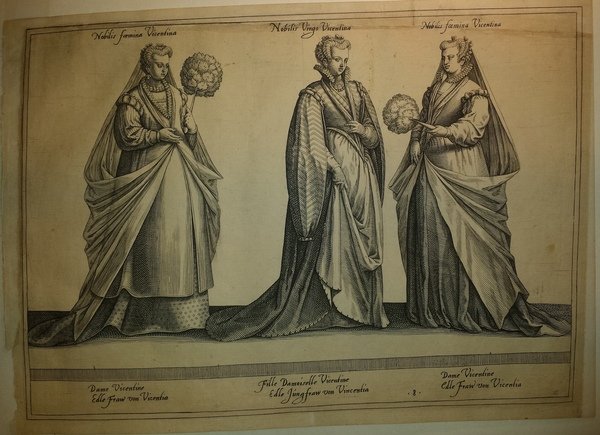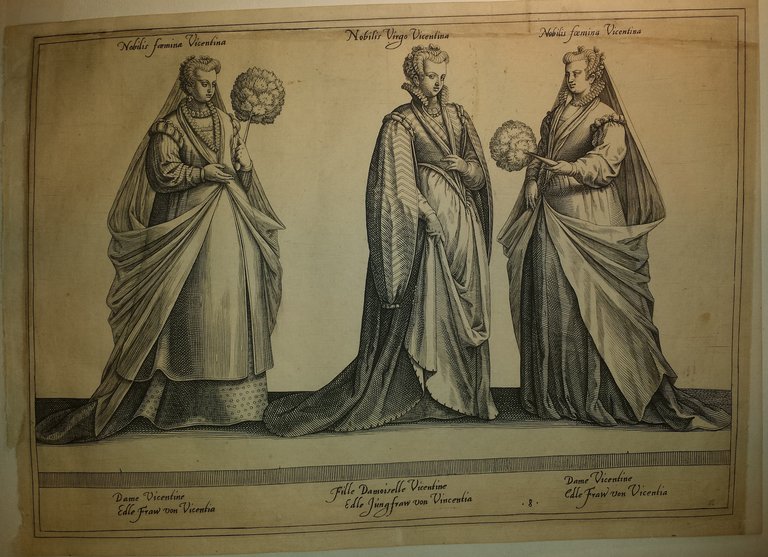Details
Publisher
Mecheln: Caspar Rutz, 1581.
Engravers
Boissard Jean Jacques, Julius Goltzius
Description
Incisione su rame di mm 235 x 302. Vergatina leggera. Filigrana fiore. Foglio di ottima qualità. In alto sopra la rispettiva immagine: "Nobilis foemina Vicentina. Nobilis Virgo Vicentina". In basso sotto la rispettiva immagine "Dame Vicentine; Edle Fraw von Vicentia. Fille Damoiselle Vicentine; Edle Jungfraw von Vicentia. Dame Vicentine; Edle Fraw von Vicentia". Quindi indicazione della tavola n "8". Proviene da "Habitus variarum orbis. Habitz de nations estrages. Trachten mancherley volcker des erdskreys." Caspar Rutz, Mecheln 1581. Jean-Jacques Boissard (1528 - October 30, 1602) fu un antiquario francese e un poeta. Nacque a Besançon e fu educato a Leuven, ma disgustato dal suo istruttore, lasciò segretamente il seminario e viaggiò attraverso la Germania per arrivare in Italia, dove rimase numerosi anni, spesso ridotto in povertà. Il tempo rascorso in Italia lo educò al gusto per l'antiquariato. Visitò quindi le isole greche finchè una grave malattia non l'obbligò a tornare a Roma. Completata la sua collezione di artefatti antichi romani, tornò in Francia, ma non potendo praticare la religione Protestante, si trasferì a Metz, dove rimase fino alla sua morte. Julius Goltzius era il figlio di Hubrecht Goltzius, e divenne egli stesso pittore. Non si sa molto di lui tranne che si sposò ad Anversa il 27 settembre 1581 e morì circa nel 1595. Le sue maggiori opere furono le incisioni dei quattro Evangelisti sono conservati al "Dutch Renaissance History Painting". Jean-Jacques Boissard (1528 - October 30, 1602) was a French antiquary and Latin poet. He was born at Besançon and educated at Leuven; but disgusted by the severity of his master, he secretly left the seminary there, and travelled through Germany to Italy, where he remained several years and was often reduced to poverty. His time in Italy gave him a taste for antiquities, and he soon formed a collection of curious artefacts from Rome and its vicinity. He then visited the islands of Greece, but a severe illness obliged him to return to Rome. Here he resumed his favourite pastimes, and having completed his collection, returned to France; but not being permitted to profess publicly the Protestant religion, which he had embraced some time before, he withdrew to Metz, where he remained till his death. Julius Goltzius was the son of Hubrecht Goltzius, himself a painter of "History Paintings" and followed in his father's and his teachers' footsteps. We know little about him save that he was married in Anvers / Antwerp on 27 September 1581 and died about 1595. His engravings of the four Evangelists are in the mainstream of Dutch Renaissance History Painting and the needs of the print market in the late 16th century in a country in revolt from King Philip II of Spain, their hereditary ruler but a Catholic, and riven by civil war between Catholics and Protestants. The choice of subject matter is appropriate for Catholics but would also especially appeal to Protestants seeking a biblically-based religion. Although Goltzius has been identified as the son of Hendrick Goltzius, Benezit rejects that assertion. According to the St. Matthew and St Mark engravings, the works are based upon drawings by Anthonie Blocklandt, a pupil of Frans Floris and an artist influenced by Parmigianino during a 7-month trip to Italy; in 1577, he entered into the Painter's Guild in Utrecht in 1577. The works were published by Hans II Liefrinck, a painter, engraver, and print publisher active in Anvers from 1581 on. Graesse p. 454


Find out how to use
Find out how to use

